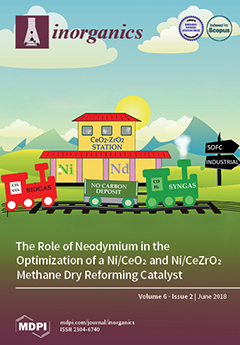Surface-bound heteroleptic copper(I) dyes [Cu(L
anchor)(L
ancillary)]
+ are assembled using the “surfaces-as-ligands, surfaces as complexes” (SALSAC) approach by three different procedures. The anchoring and ancillary ligands chosen are ((6,6′-dimethyl-[2,2′-bipyridine]-4,4′-diyl)-bis(4,1-phenylene))bis(phosphonic acid) (
3) and 4,4′-bis(4-iodophenyl)-6,6′-diphenyl-2,2′-bipyridine (
4), respectively. In
[...] Read more.
Surface-bound heteroleptic copper(I) dyes [Cu(L
anchor)(L
ancillary)]
+ are assembled using the “surfaces-as-ligands, surfaces as complexes” (SALSAC) approach by three different procedures. The anchoring and ancillary ligands chosen are ((6,6′-dimethyl-[2,2′-bipyridine]-4,4′-diyl)-bis(4,1-phenylene))bis(phosphonic acid) (
3) and 4,4′-bis(4-iodophenyl)-6,6′-diphenyl-2,2′-bipyridine (
4), respectively. In the first SALSAC procedure, the FTO/TiO
2 electrode is functionalized with
3 in the first dye bath, and then undergoes ligand exchange with the homoleptic complex [Cu(
4)
2][PF
6] to give surface-bound [Cu(
3)(
4)]
+. In the second method, the FTO/TiO
2 electrode functionalized with
3 is immersed in a solution containing a 1:1 mixture of [Cu(MeCN)
4][PF
6] and
4 to give surface-anchored [Cu(
3)(
4)]
+. In the third procedure, the anchor
3, copper(I) ion and ancillary ligand
4 are introduced in a sequential manner. The performances of the DSSCs show a dependence on the dye assembly procedure. The sequential method leads to the best-performing DSSCs with the highest values of
JSC (7.85 and 7.73 mA cm
−2 for fully masked cells) and overall efficiencies (
η = 2.81 and 2.71%, representing 41.1 and 39.6% relative to an N719 reference DSSC). Use of the 1:1 mixture of [Cu(MeCN)
4][PF
6] and
4 yields DSSCs with higher
VOC values but lower
JSC values compared to those assembled using the sequential approach; values of
η are 2.27 and 2.29% versus 6.84% for the N719 reference DSSC. The ligand exchange procedure leads to DSSCs that perform relatively poorly. The investigation demonstrates the versatile and powerful nature of SALSAC in preparing dyes for copper-based DSSCs, allowing the photoconversion efficiency of dye to be optimized for a given dye. The SALSAC strategy provides alternative hierarchical strategies where the isolation of the homoleptic [Cu(L
ancillary)
2]
+ is difficult or time-consuming; stepwise strategies are more atom-economic than ligand exchange involving the homoleptic [Cu(L
ancillary)
2]
+.
Full article





